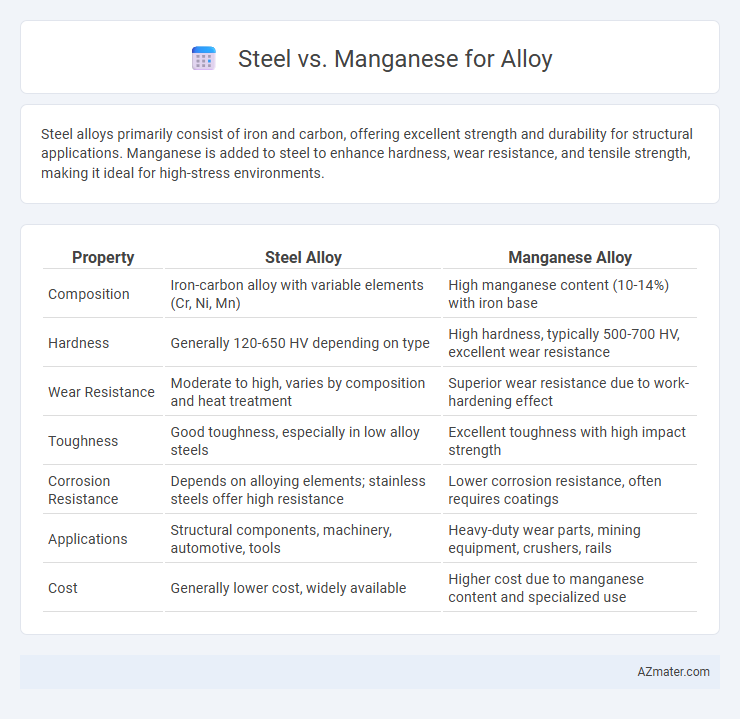Steel alloys primarily consist of iron and carbon, offering excellent strength and durability for structural applications. Manganese is added to steel to enhance hardness, wear resistance, and tensile strength, making it ideal for high-stress environments.
Table of Comparison
| Property | Steel Alloy | Manganese Alloy |
|---|---|---|
| Composition | Iron-carbon alloy with variable elements (Cr, Ni, Mn) | High manganese content (10-14%) with iron base |
| Hardness | Generally 120-650 HV depending on type | High hardness, typically 500-700 HV, excellent wear resistance |
| Wear Resistance | Moderate to high, varies by composition and heat treatment | Superior wear resistance due to work-hardening effect |
| Toughness | Good toughness, especially in low alloy steels | Excellent toughness with high impact strength |
| Corrosion Resistance | Depends on alloying elements; stainless steels offer high resistance | Lower corrosion resistance, often requires coatings |
| Applications | Structural components, machinery, automotive, tools | Heavy-duty wear parts, mining equipment, crushers, rails |
| Cost | Generally lower cost, widely available | Higher cost due to manganese content and specialized use |
Introduction to Alloy Selection: Steel vs Manganese
Steel offers versatility and strength for alloy applications, providing enhanced durability and resistance to wear. Manganese, often used as an alloying element in steel, improves toughness and hardness, making it essential for high-impact environments. Selecting between steel and manganese alloys depends on factors like mechanical properties, corrosion resistance, and specific industry requirements.
Chemical Composition Differences
Steel primarily consists of iron and carbon, with carbon content typically ranging from 0.02% to 2.14%, while manganese is commonly added in concentrations between 0.3% and 1.5% to enhance hardness and strength. Manganese alloys, like ferromanganese, contain higher manganese percentages, often 70% to 80%, combined with iron and trace amounts of carbon, enhancing deoxidizing and desulfurizing properties in steel production. The key chemical composition difference lies in steel's balance of carbon and iron for structural applications, whereas manganese alloys emphasize elevated manganese content for alloying and strengthening steel.
Mechanical Properties Comparison
Steel alloys typically exhibit higher tensile strength and hardness compared to manganese alloys, making them ideal for structural applications requiring durability and resistance to deformation. Manganese alloys provide superior impact resistance and toughness, enhancing wear resistance and fatigue strength in heavy-duty environments. The higher carbon content in steel alloys generally contributes to increased machinability, while manganese improves work hardening capabilities, creating a balance between strength and ductility.
Corrosion Resistance: Steel and Manganese
Steel alloys typically offer superior corrosion resistance compared to manganese alloys due to the presence of elements such as chromium and nickel that form a protective oxide layer on the surface. Manganese, although valuable for hardness and wear resistance, is more prone to oxidation and rust in harsh environments without additional protective coatings. Selecting steel alloys, especially stainless variants, is preferred for applications demanding enhanced durability against corrosion.
Wear and Abrasion Performance
Manganese alloys exhibit exceptional wear and abrasion resistance due to their high impact strength and work-hardening properties under stress, making them ideal for heavy-duty applications. Steel alloys, while offering good wear resistance, generally lack the self-hardening characteristic of manganese, resulting in lower abrasion durability in high-impact environments. Selecting manganese over traditional steel alloys significantly enhances longevity and performance in machinery subjected to intense wear conditions.
Common Industrial Applications
Steel alloys are widely used in construction, automotive manufacturing, and heavy machinery due to their high tensile strength and durability. Manganese is primarily added to steel to improve hardness, wear resistance, and impact strength, making it essential in manufacturing railway tracks, mining equipment, and industrial machinery components. The combination of steel and manganese alloys optimizes performance in demanding industrial applications that require toughness and resistance to abrasion.
Cost and Availability Factors
Steel alloys generally offer lower costs and higher availability compared to manganese alloys due to widespread production and abundant raw materials. Manganese, often used in specialized steel grades to enhance hardness and wear resistance, tends to drive up alloy price because of its relatively limited supply and extraction complexities. Manufacturers prioritize steel alloys for cost-effective mass production while reserving manganese additions for performance-critical applications where availability constraints are justified.
Machinability and Fabrication
Steel alloys generally offer superior machinability compared to manganese alloys due to their balanced carbon content and microstructure, which enable smoother cutting and finishing processes. Manganese, while enhancing strength and wear resistance, can reduce machinability because of its hardness and tendency to cause tool wear during fabrication. Selecting the appropriate alloy depends on the desired trade-off between ease of machining and mechanical properties like toughness and abrasion resistance.
Sustainability and Environmental Impact
Manganese, used primarily as an alloying element in steel, improves strength and hardness with a relatively lower environmental footprint compared to producing high-grade steel alone. Steel production involves significant carbon emissions and energy consumption, but incorporating manganese can enhance recyclability and reduce the need for additional processing. Utilizing manganese alloys in steel manufacturing supports sustainability by extending material lifespan and enabling efficient resource utilization in construction and automotive industries.
Choosing the Right Alloy for Your Project
Choosing the right alloy depends on your project's specific requirements for strength, wear resistance, and toughness. Steel alloys offer superior tensile strength and versatility for structural applications, while manganese alloys provide exceptional impact resistance and durability in high-wear environments such as mining or heavy equipment. Evaluating the operational conditions, including stress levels and exposure to abrasion, ensures optimal alloy selection for enhanced performance and longevity.

Infographic: Steel vs Manganese for Alloy
 azmater.com
azmater.com